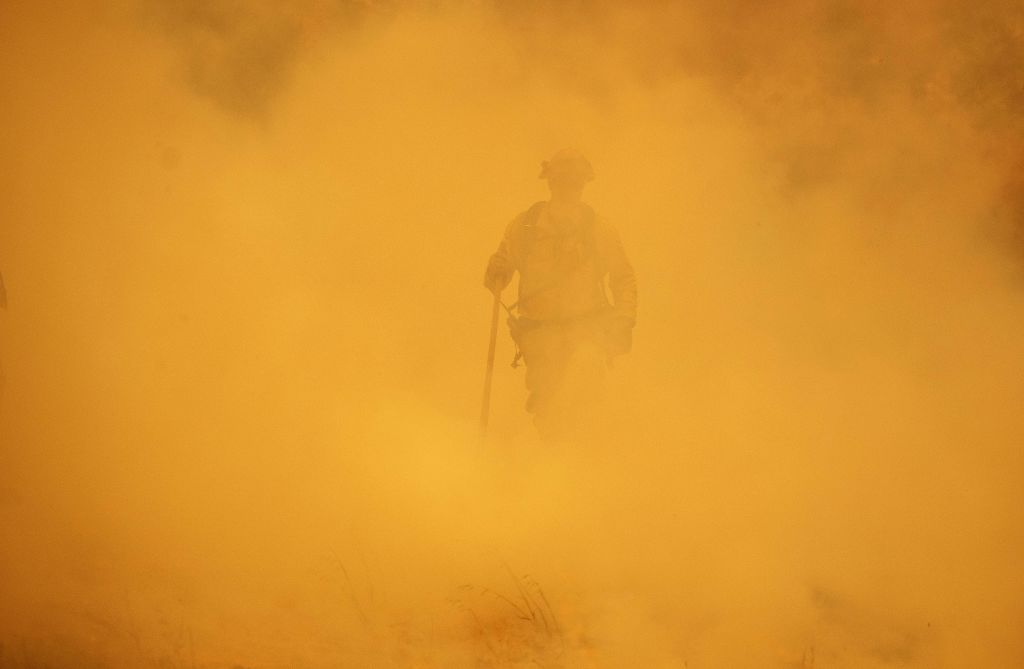| Above: Yosemite’s iconic Half Dome lies shrouded in wildfire smoke on this webcam view taken at 12:54 pm PDT August 3, 2018; Image credit: Yosemite Conservancy. |
Smoke from the raging fires in California has brought dangerously high levels of fine particulate pollution (PM2.5, particles less than 2.5 microns or 0.0001 inch in diameter) to portions of California, Oregon, and Nevada since late July, and wildfire smoke now covers more than half of the continental U.S. and much of Canada (Figure 1). Much of this smoke is due to the largest fire in California history, the Mendocino Complex, which had burned over 292,000 acres as of August 8, and was just 34% contained. A major amount of smoke has also come from the sixth deadliest fire in California history, the Carr fire, which has killed 7 people and burned over 172,000 acres, and is 47% contained. According to the National Interagency Fire Center, on August 8 there were 107 active large fires in the U.S., which had collectively burned over 1.6 million acres.
 |
| Figure 1. Smoke from fires in North America (grey colors) as observed on August 7, 2018. The colored circles and triangles show the air quality index (AQI) at EPA PM2.5 monitors. Image credit: EPA. |
Yosemite remains closed due to smoke
Yosemite National Park has been closed since July 25, thanks to smoke from the Ferguson fire. At 95,000 acres burned, this is the third largest active fire in California. This fire is most active in the Merced gorge east of El Portal, where smoldering and occasional flare-ups are contributing to the smoke hanging in the Yosemite area. Two people have died in that fire, which is 43 percent contained. The northern third of the park remains open, but this is the most extensive closure of the park since 1997, when flooding forced a two-month closure.
On three consecutive days, July 26 – 28, hourly levels of PM2.5 pollution in Yosemite peaked above a suffocating 400 μg/m3, thanks to smoke from the Ferguson fire. On August 3, a personal air pollution sensor made by purpleiar.org recorded even higher levels of PM2.5 at Wawona, on the south side of the park: an insanely high 1044 μg/m3. There is no EPA 1-hour standard for PM2.5, but the 24-hour standard is 35 μg/m3, and PM2.5 levels in excess of 250 μg/m3 maintained for an entire day are considered “hazardous”—the highest level on the Air Quality Index (AQI) scale. The highest 24-hour PM2.5 levels in Yosemite were 166 μg/m3 on July 28, which is solidly in the purple “very unhealthy” range. At this level, EPA warns to expect “Significant aggravation of heart or lung disease and premature mortality in persons with cardiopulmonary disease and the elderly; significant increase in respiratory effects in general population.”
Лесные пожары в Калифорнии признаны крупнейшими в истории штата.
— Oleg Artemyev (@OlegMKS) August 7, 2018
Очень тяжело за этим наблюдать, хочется, чтобы люди как можно быстрее победили в этой схватке с огнем...
.
Captured images of the largest #wildfires in #California history. It is truly heart-rending to witness... pic.twitter.com/11OAN40V97
Other hazardous smoke observations
A number of EPA pollution monitors in California, Nevada and Oregon adjacent to the California fires have measured 24-hour pollution levels in the purple “Very Unhealthy” range. Here is a list of some of the monitoring sites that have measured 1-hour PM2.5 pollution levels above the “Hazardous” threshold of 250 μg/m3 :
Tahoe City, CA: 991 μg/m3 , August 4
Anderson, CA: 383 μg/m3, August 2
Ranchos, NV: 432 μg/m3, August 6
Carson City, NV: 258 μg/m3, August 6
Cave Junction, OR: 350 μg/m3, July 31
Provolt Seed Orchard, OR: 302 μg/m3, August 1
Klamath Fall, OR: 292 μg/m3, August 3
 |
| Figure 2. A firefighter emerges from smoke from the largest fire in California history, the Menocino complex, on July 30, 2018. Image credit: Josh Edelson/AFP/Getty Images. |
The forecast: more hot and dry weather
July 2018 was the hottest month ever recorded in California, beating July 1931, and hot and dry conditions are predicted for California and the Northwest U.S. for at least the next ten days. Redding California, hard-hit by the Carr fire, is expecting highs each day of 98 – 105°F. The heat will extend into Alberta, Canada, where all-time record heat is possible Friday and Saturday. California’s fire season doesn’t peak until October, so we can expect two more months of extreme fire activity and wildfire smoke causing poor air quality across much of the Western U.S.
Wildfire smoke contributes to tens of thousands of deaths each year in the U.S.
A July 2018 paper by Colorado State's Bonne Ford and co-authors estimated that wildfire smoke contributed to 17,000 premature air pollution deaths each year in the U.S. in the year 2000. This number was expected to rise to 44,000 deaths per year by the year 2100, if we follow a “business-as-usual” approach to climate change (RCP8.5 scenario), which would lead to a steady increase in U.S. wildfires. For the period 1997 – 2006, Johnston et al. estimated an average of 339,000 premature deaths occurred each year worldwide due to inhalation of wildfire smoke; Koplitz et al. (2016) found that the death toll from the air pollution associated with the 2015 Indonesian forest fires alone was over 100,000. Since these causes of death are also due to other factors—such as lifestyle and family history—we typically refer to air pollution deaths as premature deaths. A premature air pollution-related death typically occurs about twelve years earlier than it otherwise might have, according to Caiazzo et al., 2013.



